Over 40 heavy work activities for kids, toddlers, and preschoolers that are designed to help calm and improve attention. Many of these activities can be done through natural activities your child is already doing!
I told myself, “Take a deep breath.”
Here we were again, in the middle of a grocery store, and my son was acting like a wild man (or, as others may say, a hyperactive child). Something almost seems to overtake him when he gets ramped up, which is often the case in stores. He seems not to hear any directions I’m giving him like, “Walking feet and hands to yourself.”
He runs, spins a little, crashes into things, and is very loud. He is clearly dysregulated.
Since I was fixated on finding the green beans, my patience level was dropping quickly, hence the deep breath. That’s when an occupational therapy/sensory trick popped into mind: heavy work activities.
I was in the perfect spot to leverage this. Now that I was thinking clearly, I went over to him, placing a hand firmly on his shoulder to get his attention, and spoke simply, right into his face so that I knew he heard me. I said, “I need your help getting our food.” We headed to the canned goods aisle and I had him pick up and put everything he could into the cart.
In part, this strategy was successful because it gave him a sense of purpose and a way to funnel his energy, but he was also getting lots of calming proprioceptive input through this heavy work activity.
What Are Heavy Work Activities?
Heavy work activities are anything that involves pushing, pulling, or lifting heavy objects or items, and they are a type of sensory activity. Lots of playground activities and household chores qualify as heavy work activities, but they can also be planned and orchestrated with a few key items these activities are great for sensory seekers, or kids who need more sensory input to feel calm and focused.
How Can Heavy Work Activities Help Kids?
The key ingredient to every heavy work activity is that it stimulates our sense of proprioception, which is one of our senses that you may have never learned about. If this is a totally new concept to you, check out this quick run down about the 7 senses.
Proprioception is stimulated through running, jumping, crashing, hugging, climbing, pushing, lifting, and pulling. MANY kids, adults, and those with special needs like Autism and Sensory Processing Disorder (SPD), relax, calm down, and even have improved focus when they get proprioceptive input. Heavy work is one direct way to get that type of input through an organized activity.
In the same way that my son was able to calm and focus in a busy grocery store, heavy work activities can also help at home and be a natural way to get sensory needs met with very little effort. As an occupational therapist, I love that!
Of course, as with any sensory activity, heavy work is not a one-size-fits-all kind of deal.
While some children, with or without a diagnosis, respond very well to them, they may have little affect on others. When a child does show calming and improved attention, there are a ton of different ways to either incorporate them into your routine or set aside some time to make them happen. They work beautifully with a sensory diet.
Learn what a sensory diet is here.
When to Use Heavy Work Activities
Heavy work activities can be used in a pinch, like the grocery store, or as part of a plan that’s been thought out in advance. For instance, you might notice that every time your 7 year old gets home from school, they’re bouncing off the walls, fidgety, and have a hard time communicating. You have seen other signs that they like proprioceptive input (aka excessive jumping or crashing into things).
You could have some options for heavy work activities shortly after he gets home, maybe he can rake up the leaves or unload the groceries? Or, perhaps he gets on the swing set and does some pull-ups?
The opportunities are endless and the list of heavy work activities below will help you figure out some possibilities for your child.
Keep in mind that heavy work activities might just be one of an arsenal of tools you have for helping your child regulate their sensory needs and thus improve their ability to relax and be attentive. Your child may not want to do heavy work activities every single day. Some days, they may want to jump on a trampoline or hang out in their cool down tent.
Sensory diet cards can be a great tool when you want your child to have some options with a visual prompt to help them.
Lastly, it’s important to never force sensory activities, the only exception is if your child needs to complete their chores, which may also happen be laced with heavy work!
Super List of Heavy Work Activities for Kids, Toddlers, and Preschoolers
Since there are so many options for heavy work activities, I’ve organized them into a few categories to help you find the best options for your child.
Heavy Work Activities that Occur Naturally
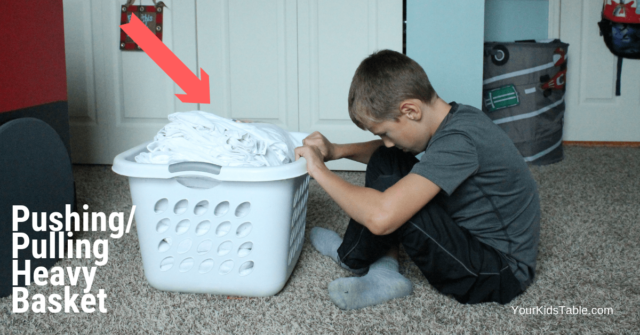
The opportunity for these heavy work activities will often occur naturally in your routine. Going to the grocery store or playing on a swing set are something that most kids are experiencing anyhow. Here are some examples:
- Load groceries into cart
- Carry groceries from car to house
- Unload groceries at home
- Climb up a slide
- Push a full grocery cart
- Carry delivered packages into the house
- Army crawl during play or to transition to the next activity (i.e. army crawl from the kitchen to the living room for reading a book together)
- Push another child on a swing
- Chair push ups (use arms on sides of chairs to raise and lower body, perfect for a school setting or any table activities).
- Stack rocks or stones while playing outside
- Push open doors to stores/doctors office/etc.
Chore Based Heavy Work Activities
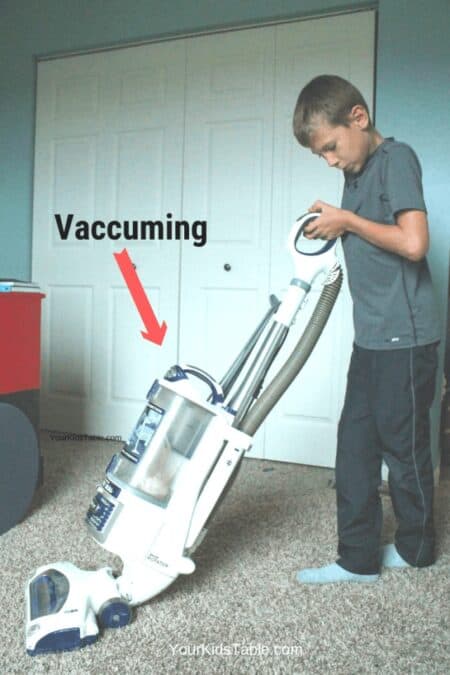
Young children, and even toddlers, can help with these activities, while older children may have them as a responsibility or a chance to earn some allowance. Whatever the case, these are all tasks that need done around most homes, which again allows for a natural way to include them in your child’s day. These are a some ideas:
- Rake leaves
- Shovel snow
- Dig a hole
- Take out garbage
- Carry full laundry baskets
- Change laundry between washer and dryer
- Push lawnmower (teens and older kids)
- Carry firewood
- Mop the floor
- Dust the furniture
- Scrub the floor on hands and knee
- Vacuum
- Clean the windows
- Collect broken branches and sticks
- Push a wheelbarrow
Heavy Work Activities for Toddlers
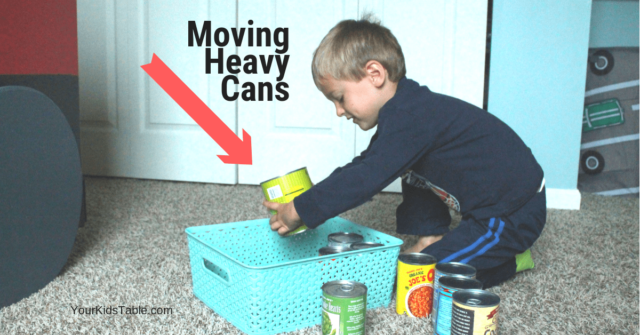
Many of the above activities can be adapted for younger children and toddlers. Think simpler and not as heavy. Use your best judgement about what’s safe and appropriate for your child. These activities will be particularly appropriate for toddlers and young preschoolers:
- Moving canned goods into a basket with two hands
- Pushing and pulling an empty or lighter laundry basket
- Pushing/pulling a toy shopping cart with some books or heavier items inside
- Tie a rope around a box or to a laundry basket and allow them to pull it.
Heavy Work Activities With the Help of Some Tools
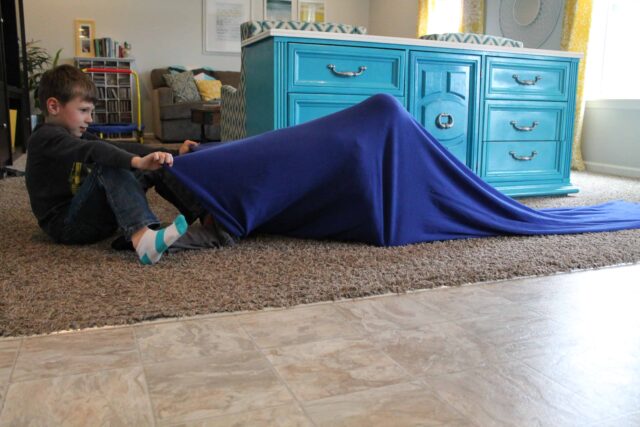
Affiliate links used below. See our full disclosure.
These are some of my favorite tools and sensory toys for creating heavy work activities. These activities can be helpful if your child needs a lot of input:
- Roll, push, or catch a medicine ball (Be careful to make sure it’s not too heavy for young children)
- Load a cart or scooter board with heavy items (books or cans) and push it around or move it from point A to point B
-
- Find scooter boards here or if you’re handy make your own.
-
- Have laundry basket races (fill laundry baskets until heavy and slide across carpet)
-
- Everyone has a laundry basket!
-
- Carry a large ball (think yoga ball)
- Push a yoga ball across the room
- Carry small weighted balls in a backpack
-
- Find these weighted sensory balls here.
-
- Move small weighted balls between two buckets
- Climb a rock wall
-
- You can drill these “rocks” into walls and playground equipment
-
- Pull a scooter board with a rope
-
- A jump rope works great
-
- Lay on belly across a scooter board and use hands to push around
- Tug of War
-
- Obviously, you’ll need a rope!
-
- Crawl through a fabric tunnel (this provides a lot of resistance).
-
- Find a ready-made sensory tunnel here or check out my sensory tunnel post with DIY instructions.
-
- Hold up the wall
-
- Lean into the wall with both palms, arms straight as if you’re holding up the wall.
-
No matter what type of heavy work activity your child is doing, remember that you’ll want to look for their response. Do they seem focused and relaxed either during or after the activity? Would it help to follow up with some sensory input like listening to quiet music, swinging, or hanging out in a cool down spot?
It’s important to know why we’re giving sensory activities to our kids and not just do them for the sake of doing them. Understanding why, and seeing the benefit, helps you choose heavy work activities wisely in the future.
If you need help planning your child’s sensory activities or building a sensory diet that is easy, grab our sensory diet template printable!
Now I want to hear from you, what were you surprised to learn was a heavy work activity and how are you going to use them with your kiddo. Scroll down and tell me in the comments!!
More Sensory Activities
100+ Awesome and Easy Sensory Diet Activities
45 Essential Vestibular Activities and Input Ideas
The Big Super Safe List of Messy Play for Babies and Toddlers
Powerful Proprioceptive Activities that Calm, Focus, and Alert
Did you pin this?
You could need this list again, know where to find it and pin it!
Alisha Grogan is a licensed occupational therapist and founder of Your Kid’s Table. She has over 17 years experience with expertise in sensory processing and feeding development in babies, toddlers, and children. Alisha also has 3 boys of her own at home. Learn more about her here.
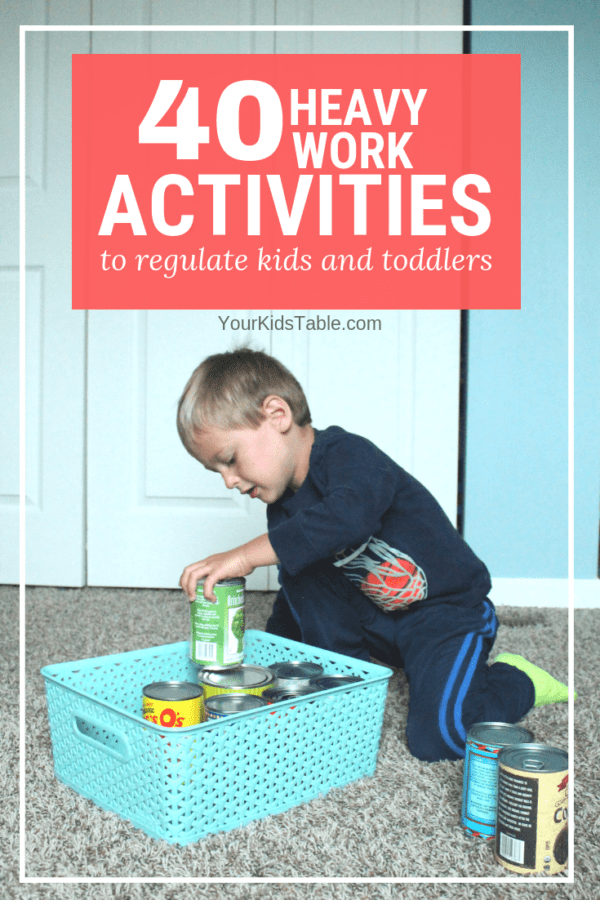
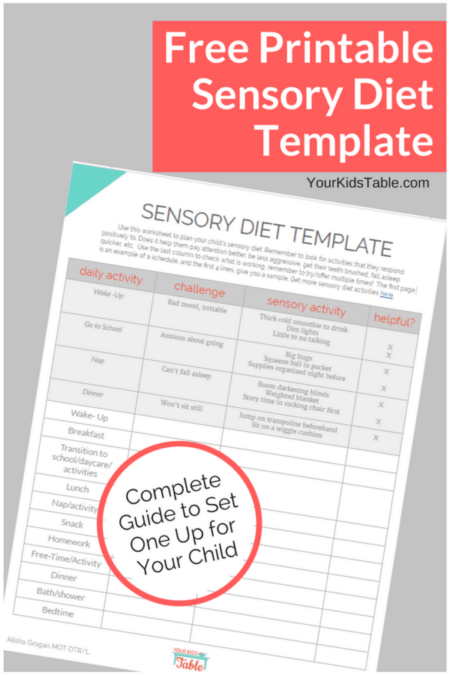
I absolutely loved this post! The heavy work activities are not only fun but also seem like a great way to help my kids focus and regulate their energy levels. I can’t wait to try out the suggestions you provided, especially the push and pull activities. Thank you for sharing such practical ideas!
This is such a fantastic resource! I love the idea of using heavy work activities to help regulate my kids’ energy levels. I can’t wait to try out some of these suggestions at home. Thank you for sharing these practical tips!
I love the heavy work and proprioception ideas. Are they available in a printable list?
Hi Angela,
This idea is in the works! I will be sure to check back with you when we get something like this together. Thank you for reading!
Best,
Laura
Your Kid’s Table team member
A really nice description on how to stimulate proprioceptove input, thank you. I was surprised to read that carrying a yoga ball would be considered heavy work but my son is also super strong 🙂
Great Jamie, I’m glad you enjoyed! Hopefully these help!
Best,
Desiree
Thanks for helping me make sense of this. This is all pretty new to me and my 2.5 year old son just got diagnosed with this. It’s definitely a bit scary but it’s good to for us to have a game plan. All his behavioral cues are all starting to make sense – jumping off of furniture, sliding chairs around, walking on tip toes, watching tv from a few inches away, running and charging into us or the couch hard. These tips on this website seem great and I’m excited to try many of these. There’s also things we figured out on our own that worked really well with him. I like to do this little comfort routine with him when he’s bouncing off the walls – I say and give him Hugs, Tickles, and Kisses (and repeat as needed) and it’s worked pretty well to mellow him out. Thanks!
Thanks so much Vince for letting us know and sharing your story. It can be hard to navigate but with the right resources you can really help your child and support them along the way. We do also have a free workshop that goes more in depth about sensory and behavior. If you are interested in learning more you can save your seat HERE
Best,
Desiree
Hi! Are these things mentioned also signs of sensory issues ?
walking on tip toes, watching tv from a few inches away, running and charging into us or the couch hard.
Hey Zane,
They could be signs of a sensory difference, but I’d check out this POST
Best,
Desiree
Yet one more great reminder from you…definitely seeing my DS 8 y/o grabbing heavy bags and baskets…reveling in mini-trampoline breaks from table work, and delighting in deep squeezy hugs! Just wish I was quicker to remember so many of his disruptive behaviors speak of a sensory need! Thank for opening this world to me!
Oh Carrie, you’re so welcome and let me tell you when I’m wearing my mom hat, I miss these things in my kids sometimes too!
Love these strategies and they make so much sense! All schools should have this on the teacher training to look out for! Now I know why my son loves and is so focused on gymnastics and Taekwondo, why he jumps up and down etc etc. And why he constantly plays with dinosaurs – all those spikes, teeth and different shapes, all meeting his sensory needs. I shall be sharing this with his SEN teacher and look to incorporate some of these strategies at school. Thank you!
YAY!!! I love hearing this Claire, seriously I’m such a dork about sensory and I love when a parent gets to learn this about their child for the first time!!
This is so great. My 3 hear old has been kicked out of a daycare because they thought he was autistic or some kind of special needs because he wouldn’t focus or listen well. His doctor completely disagrees and says he just has a lot of energy and is stubborn. We have done this type of stuff in the past, like letting him carry a 5lb bag of potatoes from the store to the car, which he loved, without know what it was called that we were doing. I have to remember some of these ideas because it truly does work!
That’s great Kira! So many everyday activities can achieve results!